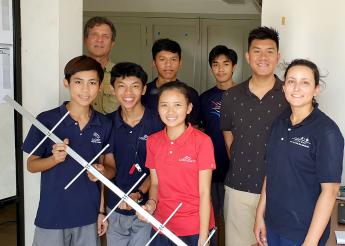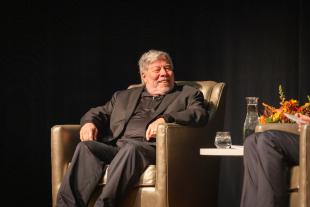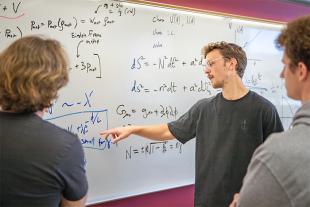One Student and Professor Help Cambodia's Quest to Launch Its First CubeSat

The pair spent 10 days developing and testing a ground station that can communication with orbiting satellites
A two-person team from Cal Poly helped the Cambodian space program get off the ground in August.
The pair traveled to the capital city of Phnom Penh to assist a group of high school seniors, with the goal to install and test the students’ ground station for tracking satellites — not to launch a national program. But they were happy to play a role in the potentially history-making student project as well as the bigger picture of lifting the nation into orbit.
“They are pioneers,” Pauline Faure, an assistant professor of aerospace engineering at Cal Poly, said of the students. “There is no university — no school — in Cambodia with a space curriculum or even close to it. So, one of the outcomes for these seniors is to start developing a space curriculum and then spreading the word about it to further ignite interest in STEM education. It might start from a high school but then hopefully it will spread to a university and beyond.”
 Nguyen instructs several Liger Leadership Academy students in how a tracking ground station works.
Nguyen instructs several Liger Leadership Academy students in how a tracking ground station works.
For about a year, Faure has been working with a group of science, technology, engineering and mathematics students from the Liger Leadership Academy who want to build a small satellite — a first for Cambodia.
The English-language boarding school, which offers scholarships to 110 gifted students from disadvantaged backgrounds, uses project-based learning to help its students, aged 12-18, succeed in education and their careers and to create future leaders who will initiate change in the developing country of nearly 16 million.
For their project, the group of five ambitious Liger seniors looked to the stars. Their vision is: to build capacity for space interests and create a path for future space missions in Cambodia. To accomplish that, they intend to build and launch a softball-size CubeSat, in order to inspire secondary and undergrad students to learn more about space education by implementing their own mini-ground station to communicate with our CubeSat.
CubeSats are a variety of nanosatellites. The standard was developed more than 20 years ago by a Cal Poly professor and a Stanford University colleague to give students the opportunity to design, build and see their spacecraft launch into space.
Since 1998 more than 2,000 CubeSats have been or are planned to be launched, according to the Nanosatellite and CubeSat Database. Since 2003, Cal Poly has launched more than 10 CubeSats, and students have worked on such high-profile missions as MarCO, whose twin six-unit satellites traveled to Mars in 2018, and The Planetary Society’s LightSail project, an experimental solar-sailing satellite that in July successfully harnessed photons from the sun to propel the craft.
Cambodia has no space program and no satellites, although the government is considering developing one to monitor the border and/or provide space-based Internet service to a nation that remains one of the poorest in Asia.
Faure said the first step for the Liger space pioneers “was to establish an amateur radio ground station” to monitor the satellite. “By developing the ground station, they also plan on developing training and STEM activities to be spread throughout Cambodia, while applying for funding to develop the CubeSat,” she said.
Faure and Justin Nguyen, a computer engineering senior from Fremont, California, arrived Aug. 8. Nguyen is also a member of the Cal Poly CubeSat Laboratory that builds and monitors CubeSats, and is the person in the lab who “is the most knowledgeable on all aspects of how Cal Poly’s ground station works,” Faure said.
“My role within the LigerSat team, “Nguyen said, “was to mentor them with all things ground station-related and provide assistance with the technical side of developing their ground station. The ground station is pretty complicated to understand, with many different operating modes and components, so there was lots of training involved in understanding what the components do and what their roles are with respect to amateur radio and space communications.
“I taught them about packet communication on amateur radio, antennas — and how to build them — and gave them training on how to operate the ground station.”
After 10 days, the pair succeeded in getting the station up and running. They did this using radio equipment donated by a local university and components purchased locally to fashion a handheld Yagi antenna. With additional equipment, the ground station can be added to a worldwide network linked online and accessible from Cal Poly.
“The goal is to have their station be eventually part of the Cal Poly Ground Station Network, which will allow the LigerSat team to have access to the network’s stations when their CubeSat is in orbit, and allow our team to utilize their station for some of our missions,” said Nguyen, who plans to graduate in June 2020. “This level of access also easily allows the CubeSat Lab team to assist the Liger students with any technical issues that may crop up in the future.”
Working with the Liger Academy was a point of great pride for all members of the Cal Poly CubeSat Lab, Faure said.
“Cambodia is a developing nation, so there is great respect for these high school students trying to build a CubeSat no matter what the difficulties are,” she said. “Our CubeSat Lab students are always willing to help and share their knowledge with their peers and the younger generation. This is just a part of their personality. Finding a community similarly passionate about CubeSats, and satellites in general, on the opposite side of the world is something inspiring. It’s been an honor to be part of the project.”
Nguyen called his 10 days in Cambodia “a truly rewarding experience.”
“I’ve been involved with Cal Poly CubeSat program for three years,” he said. “I have had the excitement of working in a fully developed program, but starting from scratch is something completely new. Working with these amazing kids was very inspiring. Seeing the limited resources they’ve grown up with and all the work and goals they have been able to achieve is amazing.”
As he embarks on his final undergraduate year, Nguyen said the partnership with Cambodia burnishes Cal Poly’s international reputation for its small satellite program.
“I think it also says a lot about the students in the CubeSat Lab,” he said “Students are not only pushed to work on excelling technically but are looking at ways their expertise can benefit others and examining the human aspect of all the amazing work we do.”
The LigerSat students have applied for grant from the U.S. Embassy in Phnom Penh aimed at projects that strengthen ties between the two nations through cultural and exchange programming.
“If this grant is successful, the idea will be for the high school students to come to San Luis Obispo next summer, and we will start assembling and testing their satellite,” she said. “The students will be trained for two months at Cal Poly and experience Learn by Doing here.”

From left, Faure holds an antenna while Nguyen does a test of the ground station satellite tracking equipment as a pair of Liger Leadership Academy students watch. The Cambodian students hope to build their nation’s first CubeSat. The ground station is key to tracking its program and necessary for downloading data from orbiting satellites.

Faure demonstrates the Yagi directional antenna the Liger Leadership Academy students helped to build as a part of the LigerSat team’s goal of building Cambodia’s first CubeSat. With additional equipment, the students will be able to permanently locate the antenna, reposition it electronically and link it to Cal Poly’s network of online ground stations.

Two Liger Leadership Academy students splice cabling that is part of their Cambodian high school’s satellite-tracking ground station.
In photo at the top, Pauline Faure, an assistant professor of aerospace engineering at Cal Poly, at right, and Justin Nguyen, a CalPoly computer engineering senior from Fremont, California, second from right, with the group of science, technology, engineering and mathematics seniors from the Liger Leadership Academy who want to build a small satellite hold the handheld antenna for the LigerSat ground station. Also pictured, at rear left, is Doug Bender, a retired Boeing Co. engineer who knew about CubeSats through his former job and connected the Liger Academy with Cal Poly.




